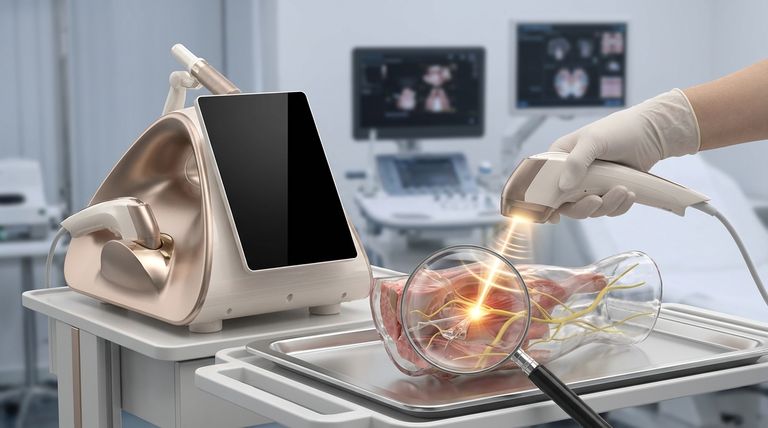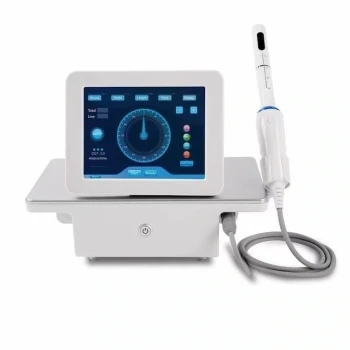The primary downside of HIFU is the risk of damage to healthy tissues surrounding the targeted area, which can lead to significant, and sometimes long-term, complications. While designed to be precise, the intense heat used in the procedure can affect adjacent structures, most notably those controlling urinary function and erectile performance.
The core issue with High-Intensity Focused Ultrasound (HIFU) is not a flaw in its concept, but a limitation of its application. The heat that effectively destroys cancerous cells can also cause collateral damage to the delicate systems controlling continence and erections that lie in close proximity.

How HIFU Works (And Why It Creates Risk)
High-Intensity Focused Ultrasound is a non-invasive thermal therapy. It works by concentrating sound waves on a small, specific point inside the body to rapidly heat and destroy tissue, much like a magnifying glass focuses sunlight to burn a hole in a leaf.
The Source of Complications
The prostate gland is situated in a complex and crowded neighborhood. It is wrapped around the urethra (the tube that carries urine out of the body) and is surrounded by a network of nerves and muscles essential for both urinary control (the urinary sphincter) and erectile function.
The risk of HIFU arises because the boundary between the targeted cancerous tissue and these vital healthy structures can be millimeters thin. Even with precise imaging, ensuring the destructive heat affects only the target is the procedure's greatest challenge.
Primary Downsides and Side Effects
While many patients experience a good outcome, potential negative effects must be carefully considered. These can appear immediately after treatment or develop over time.
Urinary Problems
This is one of the most common concerns. Damage to the urethra or the urinary sphincter can lead to several issues.
- Urinary Incontinence: You may leak urine, especially during activities like coughing, sneezing, or exercising (stress incontinence). The provided reference correctly notes this risk is significantly higher if you have previously undergone external beam radiotherapy.
- Urinary Obstruction: Swelling after the procedure can temporarily block the flow of urine, often requiring the use of a catheter for a short period.
- Other Irritations: Some men experience a more frequent or urgent need to urinate.
Erectile Dysfunction (ED)
The nerves responsible for triggering an erection are located in bundles along the sides of the prostate. If these nerves are damaged by the heat from HIFU, it can result in difficulty achieving or maintaining an erection.
The likelihood of developing ED depends heavily on your function before the procedure and the precise location of the tissue being treated.
Other Potential Issues
- Fistula: In very rare cases, a fistula (an abnormal connection) can form between the rectum and the urethra, which is a serious complication requiring surgical repair.
- Incomplete Treatment: HIFU may not destroy all of the cancerous cells, potentially requiring additional treatment later on. This is less a side effect and more a risk of treatment failure.
Understanding the Trade-offs
No treatment is without risk. The key is to weigh the side effect profile of HIFU against its potential benefits and the downsides of alternative treatments.
Precision vs. Invasiveness
HIFU's primary advantage is that it is non-surgical and non-invasive. Compared to a radical prostatectomy (surgical removal of the prostate), it typically involves less blood loss and a faster initial recovery. However, surgery may offer a higher certainty of removing all cancerous tissue.
Focal vs. Whole-Gland Treatment
Compared to radiation therapy, which often treats the entire prostate gland and surrounding areas, HIFU can be used as a "focal therapy" to treat only the cancerous part of the gland. This targeted approach is specifically intended to reduce the risk of side effects like incontinence and ED. The trade-off is a potential risk of leaving undiscovered cancer cells elsewhere in the gland.
The Operator's Skill is Critical
The outcome of a HIFU procedure is highly dependent on the skill and experience of the physician performing it. An expert operator is better able to define treatment margins to maximize cancer destruction while minimizing damage to surrounding healthy tissue.
Making an Informed Decision
Your personal risk profile depends on your pre-treatment health, tumor characteristics, and treatment goals.
- If your primary focus is preserving urinary continence: Discuss the tumor's proximity to your urinary sphincter and confirm that your risk is not elevated due to prior treatments like radiotherapy.
- If your primary focus is preserving erectile function: Ask about the location of the tumor relative to the neurovascular bundles and whether a nerve-sparing approach is feasible.
- If your primary focus is minimizing all risk: Seek a highly experienced HIFU provider and consider getting a second opinion to explore all available treatment options and their respective downsides.
Ultimately, choosing a treatment requires a clear understanding of the potential costs to your quality of life measured against the therapeutic benefit.
Summary Table:
| Primary Downside | Associated Risk/Complication |
|---|---|
| Damage to Surrounding Tissues | Urinary incontinence, erectile dysfunction, fistula (rare) |
| Urinary Problems | Incontinence (leakage), obstruction (blockage), irritation |
| Erectile Dysfunction (ED) | Difficulty achieving or maintaining an erection |
| Incomplete Treatment | Potential for cancer cells to remain, requiring further treatment |
Make an Informed Decision on Medical Aesthetic Equipment
Choosing the right technology for your clinic is critical for patient safety and satisfaction. The potential downsides of treatments like HIFU highlight the importance of reliable, precise, and expertly supported equipment.
BELIS specializes in professional medical aesthetic equipment, serving medical aesthetics clinics and premium beauty salons. We provide advanced, safe, and effective solutions to help you deliver superior patient outcomes while minimizing risks.
Contact our experts today to discuss how our equipment can enhance your practice's efficacy and safety profile.
➡️ Get a Personalized Consultation
Visual Guide

Related Products
- 12D HIFU Machine Device for Facial HIFU Treatment
- 4D 12D HIFU Machine Device for Skin Tightening
- 7D 12D 4D HIFU Machine Device
- 22D HIFU Machine Device Facial Machine
- Vaginal Tighten HIFU Gynecology HIFU Treatment
People Also Ask
- How long does it take for HIFU to show results? See the Dual-Phase Timeline for Natural Lifting
- How often should you do HIFU? Optimize Your Treatment Schedule for Lasting Results
- How long does it take for HIFU to start working? See Full Results in 2-3 Months
- Is HIFU skin tightening safe? Ensure Your Safety with a Qualified Professional
- What are the benefits of HIFU machine? Achieve Non-Surgical Skin Lifting & Tightening



















